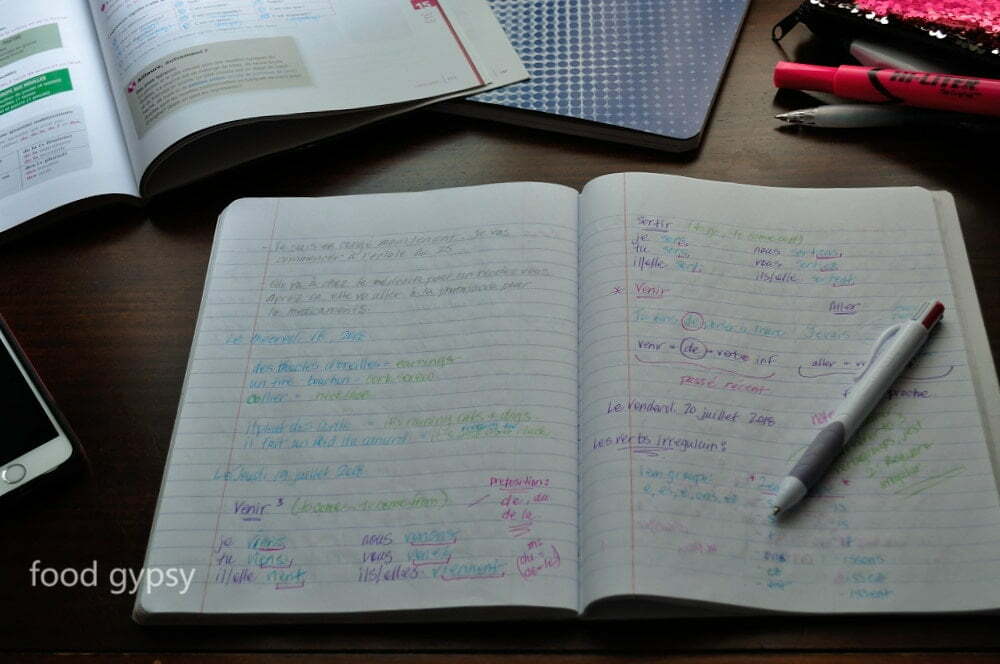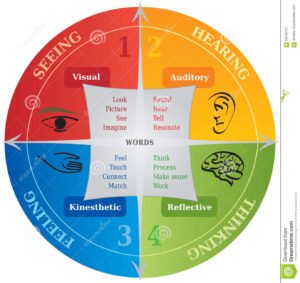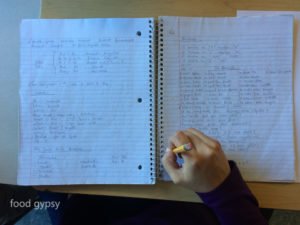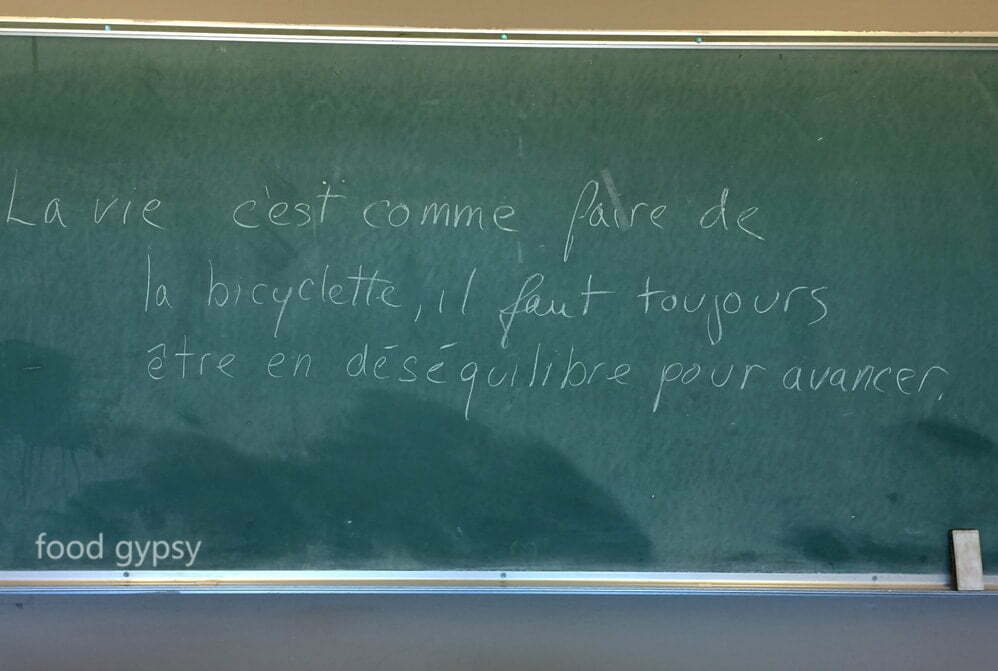As a vegetarian, it's important to make sure you're getting all the nutrients your body…

Five Tips to Learn French, FAST!
It’s back-to-school time and our house is buzzing. This year it’s not only back to school for my favorite nine-year-old, but me as well. That means school supplies, times two. I’ve been studying French, full/time since mid-March of this year. There’s no sugarcoating it, learning French as a second language French isn’t easy.
French has complex rules of grammar with multiple exceptions to each rule. Then there is the use of masculine and feminine throughout the language, plus different tenses to conjugate verbs in and, for added fun, it’s peppered with silent letters.
It has made me curse, a lot. But now I curse in two languages!
Build a Custom Learning Strategy
Being dyslexic, I process language differently than most people. So I build my own strategies to learn. I’ve shared some of these tips with others and they’ve shared their advice with me. Below are my top five, plus a couple of great study tools and links to help speed your progress. Trust me if my brain, that scrambles letters and still can’t tell left from right 50+ years later, can get a handle on this, yours can too.
Up to now, I’ve been adapting, picking up a phrase here and there, and largely… drinking wine. This strategy has served me surprisingly well through a trip to France and the last seven years living in Quebec. But at a certain point, it’s time for a deeper conversation.
So while other blogs bring you lunch box tips for kids and amazing fall recipes, I bring you… Five Tips to Learn French as a Second Language, FAST. Go with what you know…
[youtube id=”edYHlnhxyOI” width=”620″ height=”360″]1. Know How You Learn
Learning as an adult is vastly different from learning as a child, the biggest advantage being – self-knowledge. By the time you’ve reached adulthood, you should have some idea as to how you both process and absorb new information.
Knowing your learning style dictates your study habits, how you manage workflow and how quickly you assimilate knowledge.
There are four basic types of learners; visual, auditory, reflexive, and kinesthetic. Let’s break them down:
Visual learners absorb best using charts, graphics and colour. They prefer to see facts as opposed to read them, and easily visualize the relationship between ideas. When reading and memorizing facts they benefit from using highlighters and different coloured texts or creating their own study sheets blocking text and using pictures for association.
Those that learn through sound benefit from exercises that involve hearing rather than reading. They do well with audiobooks, learning through music and hearing their own voice. These types of learners do especially well with “repeat after me” exercises as they imprint through auditory exercises.
Reflexive learners do well in today’s education system because they learn through fact repetition. If this is your learning style you likely made with through school with the “Read, Write, Review” study system. These types of learners do best with text presented in different ways – handouts to be read aloud as a group, written assignments and quizzes – help to retain new concepts.
Kinesthetic learners need movement to learn. Hands-on activities and anything that requires the use of muscle memory will help to imprint and retain new information. Most kinesthetic learners make heavy use of handwritten notes because the action of writing helps them to memorize the information.
 Some of us (ahem…) are a little more complicated than colourful graphics indicate. You may be part visual and part kinesthetic. Or your brain may need a combination of all four types of information to best absorb new concepts. I am one of those people. So for me it was important to have a custom learning strategy: See it, say it, read it, write it, review it.
Some of us (ahem…) are a little more complicated than colourful graphics indicate. You may be part visual and part kinesthetic. Or your brain may need a combination of all four types of information to best absorb new concepts. I am one of those people. So for me it was important to have a custom learning strategy: See it, say it, read it, write it, review it.
TIP: I make use of colour, with my handy four-colour pen in my notebook. Blue is for french text, green is for english translation (or notes in english), purple is for structure and/or grammar and pink is for anything that I don’t yet have a handle on, or exceptions to rules.
This strategy comes from the man in my life who taught himself English, on the job, when he immigrated from France to Canada. It wasn’t easy. He shed more than a few tears out of frustration. But after one too many Halifax cabbies taking advantage of the language barrier, he sealed his resolve to be as well-spoken in his second language as he is in his first.
This is probably the best study aid I’ve ever adopted. It allows me to easily identify what I know and what I need to work on.
2. Learn Nouns WITH the Article
Welcome to the land of feminine and masculine inanimate objects. This is often a stumbling block for English speakers, who are accustomed to gendered pronouns (he or she), only being used for people, animals and insects, that actually HAVE a gender.
In French, a chair is feminine, la chaise. But book is masculine, le livre. The use of masculine and feminine also extends to places. Canada? Masculine – Le Canada. Russia? Feminine – La Russie. What about the United States of America? Right, PLURAL – Les Etats-Unis d’Amérique.
Masculine, feminine AND plural?! Yup, and that’s just the basics. Once you move past the basics you’ll find the thread of gender goes deeper, touching almost every facet of the language; prepositions, adjectives, professions, nationalities, even colour is tainted by gender in both written text and pronunciation. French is not the only language with feminine and masculine grammar; similar rules exist in Spanish, German, and others.
TIP: Learn the article with the noun. Rather than go back after learning the word and then attaching a preposition (le, la, les) learn each noun WITH the preposition as a unit –learn ‘la chaise’ or ‘une chaise’ instead of just ‘chaise’. This way as you progress you’ll be able to more easily adapt to the increasingly complicated layers of the language.
Tools: Duo Lingo is probably my favorite resource. It’s free and particularly good for beginners as it won’t let you move on until you get it right. This helps build internal references. In addition, if your first language is something other than English, you can interface in you native tongue for better comprehension.
[youtube id=”r46F3xd4IUo” width=”620″ height=”360″]3. Each Language Has Its Own Set of Rules
Let’s just spend a minute on grammar, shall we? I am not an expert in French grammar, in fact, I have come to know that I have barely scratched the surface of the subtleties of French and it’s precision. (Did I mention the SEVEN DIFFERENT TENSES? SEVEN!)
Add to that the fact that each verb you learn you will learn to conjugate in six different variances according to person, voice and number – and that is just in the present tense. That’s a lot to remember. This is the point at which you realize that you are not in Kansas anymore, Toto.
There will be times when trying to express ideas; you’ll be told “you can’t say that in French”. This used to puzzle me, but now, I get it. Even the use of a comma is different. French has strict rules that govern its usage, much in the same manner that English (or any other language) has its own boundaries.
You may frequently find yourself asking: BUT WHY?!
The simple answer is: because it’s French.
It’s FRENCH. Until you start using it, it’s not going to make sense. However, once you let go of the need to make it fit within the rules you already know, you’ll find it starts to feel less awkward and it will begin to flow.
TIP: Try to suspend what you already know of language and adapt. To do that, I replaced “why” with “how”. As in: How does it work? How do I use it? How does it apply? How do I use these new rules?
Now I have one set of rules for one language, and one (WAY more complicated) set of rules for the other. I like to think of it as building my French brain.
My French brain thinks differently than my English brain. I feel like my French brain is pickier. My English brain is all like “yeah, sure we can do that!” while my French brain is like “non, non, non, non, non, non… mon Dieu. Non.”
Tools: Try Française Facile, their pronunciation feature is really useful for home study.
[youtube id=”hd0_GZHHWeE” width=”620″ height=”360″]4. Build our Vocabulary
Language is like a muscle, you have to flex it to build it. As an adult, I find my biggest frustration is the shift from being an articulate communicator in my native tongue to speaking like a toddler in the language I’m learning. I make a lot of mistakes. I stumble through pronunciation and often can’t remember (or don’t know) the words I’m trying to say.
It’s like my French brain is stuck trying to load, and all I can do is wait until that file is retrieved. Hey, you’ve got to start somewhere. Right?! When you’re taking on a new task do you start in the middle? No, you start at the beginning. I now brutalize this beautiful language in five different tenses. Yeah me!
 Tip: Get Organized. I started a reference system of my own as I learned, in the back of my notebook. I have sections for verbs (starting with the most common verbs), nouns, adjectives, and adverbs. Then I built special sub-sections for easy reference like asking questions (who, what, when, why), then a section for the five senses, all the feeling words, plus a whole page of prepositions and directions.
Tip: Get Organized. I started a reference system of my own as I learned, in the back of my notebook. I have sections for verbs (starting with the most common verbs), nouns, adjectives, and adverbs. Then I built special sub-sections for easy reference like asking questions (who, what, when, why), then a section for the five senses, all the feeling words, plus a whole page of prepositions and directions.
This gave me an easy flip-and-refer resource which helped me to build my vocabulary quickly.
Also, I do my best to THINK in French as much as possible. I started with spelling, in my head, in the French alphabet as I was learning French words. Again, this is about flexing that French side of your muscle so instead of going back and forth and translating in your head, you start to KNOW the words, that you’re hearing, saying, reading… in that language… without translation.
Tools: A good English/French Dictionary is an absolute must! Mine contains a grammar syllabus and conjugation guide for irregular verbs. Google Translate is good in a pinch (though it is not always accurate, and it sure slows down the conversation) I like Reverso Conjugation and its associated app, as a study aid for verbs.
[youtube id=”0Pyu-phHnlU” width=”620″ height=”360″]5. Practice, Practice, Practice
The only way to get better is to make use of what you know, try to find as many ways as possible to practice. Living in Quebec I get lots of opportunities to practice, but first I had to get over the fact that I might look like an idiot just TRY. Now I do most daily tasks, like shopping, going to the post office, paying for gas, even self-check-outs and banking machine transactions – in French. Sometimes I look like an idiot. C’est la vie.
If I stumble, or if we reach the end of my French, I simply say so. I often tell people I’m studying French, which helps eliminate judgment and shift to support. After that most people open right up, they will gently correct you and cheer you on.
My French-speaking family is way tougher than that. I don’t get a pass on poor pronunciation at home. The bilinguals I love can be real hard-asses! But they’ve also proved essential in aiding my progress with great tips, active coaching.
Tip: Find someone to practice with who will correct you properly, but not harshly. Since starting with French as a second language I’ve found several resources within our circle of friends that have taught French in the past. They’re wonderful people to practice with.
Try to keep those sessions brief so you don’t overtax your resources. Meet for coffee; spend a half-hour or so, just talking about life and general conversation. This will help to build your confidence. If something is really giving you trouble, ask for that help upfront. Our brains absorb best in the first 15 minutes of any given task.
Tools: Build your listening and comprehension tools as you build your vocabulary. Read simple text, like advertising, to start. (I started with bus boards and signs.) Then build to children’s books and short magazine articles then move on to newspapers or simple books. (I have several recipe books in french. Sometimes I’ll pick up free magazines at health food stores.) I prefer to stick with subjects I’m already familiar with, and can easily understand.
Try listening to French radio, watching movies, or television in French, there so many online streaming services for this. I find watching with subtitles IN FRENCH, while watching IN FRENCH helps me to better identify words, and recognize phrases I know.
Never Surrender
If you’re taking on a second language or even a third; I applaud you. Know that even with a custom strategy you will hit learning plateaus, where you feel like you’re going nowhere. You may become deeply discouraged, or fall into confusion. Don’t give up. I have found that I am often in that space just before I make a big leap forward. It’s like my brain is hitting critical mass and just needs a rest as I push through to the other side.
It’s a Whole New World
Learning French has proved anything but easy, but the benefits are so rich. In my life it’s opened up a whole new world of art, music and literature. And on a personal note, I am now able to have (almost whole) conversations with my French in-laws, who have become two of my biggest cheerleaders. I get misty whenever I think about my father-in-law with a huge smile on his face and double thumbs up saying “SUPER BONNE! Bien pour toi!” (SUPER GOOD! Good for you!) That’s what keeps me going.
May those around you be as supportive, and as kind. Bonne chance!
Please note: This is not a sponsored post, all references are my own. If you have tips or resources for rapid learning that you’d like to share, please add them in the comments below. I’d LOVE to hear from you!




You forgot live with French people ( that helps surely ) xx
Great tips!
One more: 80/20 rule…focus on high frequency words and phrases :). Pinhok Languages has a great book for this. I don’t work for them…I only learn from them.